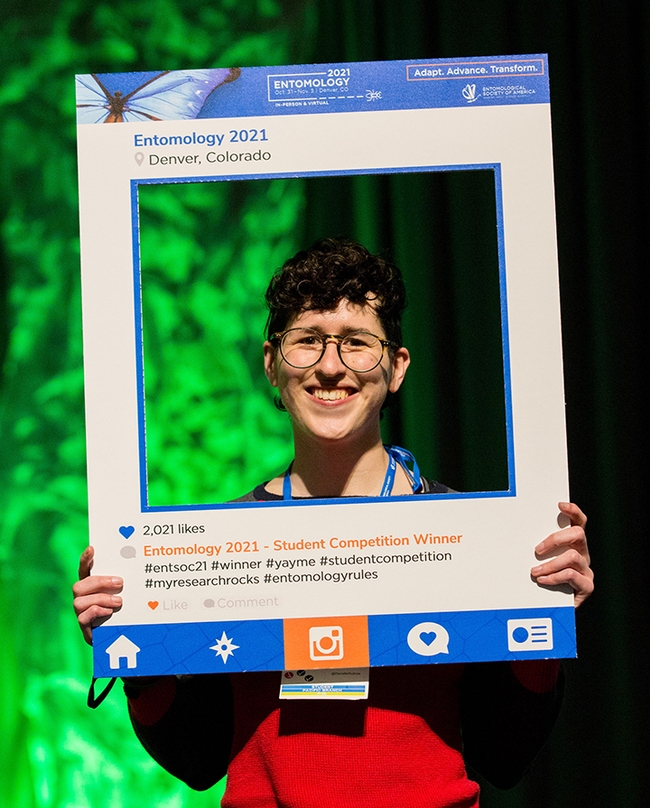When the Entomological Society of America honored its President's Prize winners at its recent meeting in Denver, it did so "picture perfect."
At the awards podium, each winning graduate student held up an empty frame lettered with "Student Competition Winner."
And filled the frame.
They included our UC Davis winner, Danielle Rutkowski, who won a President's Prize for her 10-minute oral presentation on "Fungicide Impacts on Bumble Bees are Mediated via Effects on Bee-Associated Fungi" in the category, Plant-Insect Ecosystems: Ecology 3." She studies with community ecologist Rachel Vannette, associate professor, and is also advised by community ecologist and professor Rick Karban.
At the ESA's annual meetings, students are offered the opportunity to present their research and win prizes. They can compete in 10-minute papers (oral), posters, or infographics. First-place winners receive a one-year free membership in ESA, a $75 cash prize, and a certificate. Second-winners score a one-year free membership in ESA and a certificate.
Judges awarded two other UC Davis graduate students--Maureen Page of the Neal Williams lab and Kyle Lewald of the Joanna Chiu lab--second-place honors in their respective categories. Professor Williams is a pollination ecologist and Professor Chiu is a molecular geneticist and physiologist and vice chair of the UC Davis Department of Entomology and Nematology. (See news story)
Hats off also to the 10 other UC Davis graduate students who presented their intricate research, ranging from ants to beetles to mosquitoes: Jill Oberski (president of the UC Davis Entomology Graduate Student Association), Zachary Griebenow, Lacie Newton, Lindsey Mack, Xavier Zahnle, Erin Taylor Kelly, Jasmin Ramirez Bonilla, Madison Hendrick, Mia Lippey, and Gabriel Foote. They are all winners! (See news story)
Rutkowski's abstract:
"Native bees including bumble bees are important pollinators but face threats from multiple sources, including agrochemical application. Declining bumble bee populations have been linked to fungicide application, which could directly affect the fungi often found in the stored food and GI tract of healthy bumble bees. Here, we test the hypothesis that fungicides impact bee health by disrupting bumble bee -fungi interactions. Using two species, Bombus vosnesenskii and B. impatiens, we test the interactive effect of the fungicide propiconazole and fungal supplementation on the survival, reproduction, and microbiome composition of microcolonies (queenless colonies). We found that both bee species benefitted from fungi, but were differentially affected by fungicides. In B. vosnesenskii, fungicide exposure decreased survival while fungal supplementation mitigated fungicide effects. For B. impatiens, fungicide application had no effect, but fungal supplementation improved survival and offspring production. Fungicides altered fungal microbiome composition in both species, and reduced fungal abundance in B. vosnesenskii microcolonies, but not in B. impatiens, where instead fungal addition actually decreased fungal abundance. Our results highlight species-specific differences in both response to fungicides and the nature of fungal associations with bees, and caution the use of results obtained using one species to predict the responses of other species. These results suggest that fungicides can alter bee- fungi interactions with consequences for bee survival and reproduction, and suggest that exploring the mechanisms of such interactions, including interactions within bee-associated fungal communities, may offer insights into bumble bee biology and bumble bee conservation strategies. (Paper co-authors are associate professor Rachel Vannette, Eliza Litsey and Isabelle Maalouf)
Rutkowski holds a bachelor's degree from Cornell University, where she studied how the relationship between mycorrhizal fungi and their host plants impacts insect herbivores. On the Vannette lab website, Rutkowski specifies that she studies "how bumble bees interact with the microbes, particularly fungi, in their environment, and how these relationships impact bee health."
Vannette describes her lab as "a team of entomologists, microbiologists, chemical ecologists, and community ecologists trying to understand how microbial communities affect plants and insects (sometimes other organisms too). We often study microbial communities in flowers, on insects or in soil. We rely on natural history observations, and use techniques from chemical ecology, microbial ecology and community ecology. In some cases, we study applied problems with an immediate application including pathogen control or how to support pollinators. Other questions may not have an immediate application but are nonetheless grounded in theory and will contribute to basic knowledge and conservation (e.g. how can dispersal differences among organisms affect patterns of abundance or biodiversity?)"
The Entomological Society of America, founded in 1889 and headquartered in Annapolis, Md., is the world's largest organization serving the professional and scientific needs of entomologists and others in related disciplines. Its 7000 members are in educational institutions, health agencies, private industry, and government.
Attached Images:
